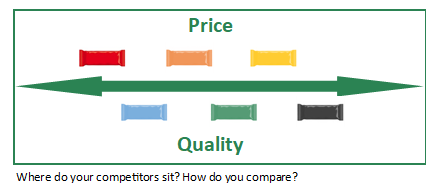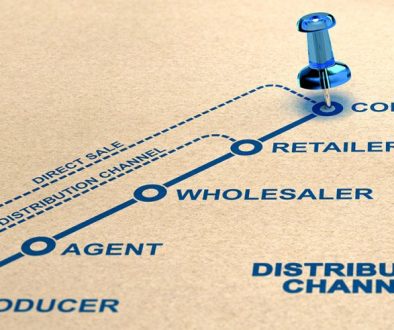Competitive Pricing. Whether it is black Friday deals, January sales or even our weekly food shop, as consumers we are fully accustomed to comparing prices to get ourselves the best price and the best value.
So, if consumers are comparing prices and making their buying decisions based on what they see from our competitors, then it makes sense for us to include this information when designing our pricing strategy too. We cannot ignore the competition and market conditions when it comes to pricing.
This is the second article in our Product Pricing Series. Last time we looked at the Cost Plus pricing strategy. One of its downsides is that it does not take the competitive environment into account. So, we are going to address that with this second article as we are going to be looking at Competitive pricing strategy. We are going to take a deeper look at competitive pricing. A look to see whether this pricing method is the best for your products or whether copying isn’t actually the best answer.
Price is one of the first things that a consumer notices about a product. It is one of the deciding factors when it comes to their decision to buy it or not. It therefore makes sense to give pricing and pricing strategy the time and effort it deserves. Competitive pricing or competition based pricing is just one of the options you have.
LEARN YOUR WAY:
What is Competitive Pricing?
Competitive pricing is where you base your pricing on your competitors’ products and prices. If you don’t know the answer to your pricing question then it is tempting to simply look around you, to do a competitor pricing analysis. You can see what everyone else is doing and then do likewise! There can be some merit in this, and it is always great to be aware of the market around you.
The Method
There are different methods for competitive pricing but here are 2 options:
- The first is simpler. It is where you look at the prices set by other businesses in the same sector for comparable products. You then implement a price just like theirs, perhaps the same or slightly above or below. You simply look at what everyone else is doing and do the same.
- The second is slightly more detailed and does require more time and analysis. This is where you take all comparable products in the marketplace whether direct or indirect competitors and order them. You scale them from the most premium at one end, to the most basic at the other. You can rank them in both price and quality. At this point you decide where in the line you want your product to go. You match your product to the price in the market where you see your product fitting best.

In both competitive price strategy scenarios, you have 3 options:
- Lower pricing than the competition
- The same price
- Higher price than the competition
The choice is yours but each one will have different implications. Here are three examples of these choices:
Competitive Pricing – Examples
- Lower: A retailer has their own brand of soup. They know the prices of the branded soups and decide to price lower. The retailer hopes to make more sales based on the assumption that consumers will choose their low-cost product over the pricier soup options. Pricing lower can help to grab people’s attention and steal market share.
- The same: A competitor is selling the same product as you. Same brand, same recipe and the product is widely known. You decide to price at the same price. As the price is the same you will have to do something different to stand out. Something different to set yourselves apart. This is often done through creative marketing and branding techniques that help create a unique value proposition. Perhaps you support a particular charity, perhaps you make your product more visible, perhaps you include a linked offer. Marketing will be key.
- Higher: You want to introduce a new TV with features never seen before. You look at your competitors and decide to price higher. But how do you attract customers to a higher price point? Well you set yourself apart from the competition by offering a premium product with a sleek design and added features. Since your competitors don’t offer these add-ons, consumers will be more likely to pick your premium TV over more basic models. Here you can justify the higher price because you are giving your consumers more value.
Who uses competitive pricing?
It is now estimated that almost 92% of shoppers are comparing prices at some point while shopping online. Therefore, many companies must use competitive pricing to ensure their consumers do not move to another competitor for their low prices.
The first type of competitive pricing method that I described is particularly relevant if your customers are very price sensitive and your competitors are reactive. Business that use platforms such as Amazon or similar, will need to use competition based pricing extensively. This is because their consumers can compare prices easily and continuously.
Almost all companies can use the second competition based pricing method. Even companies with few direct competitors can benefit from benchmarking in the marketplace. It helps you to understand your consumer, what they like and what they have been willing to pay. This research can also shape your marketing message. It can help you to show your value compared to your competitors.
Competitive Pricing: Why it’s great!
There are plenty of reasons that this pricing strategy is popular, and it does have its advantages.
Firstly, it is simple, especially if you have very few competitors. Instead of spending hours inputting formulae into spreadsheets, all you must do is copy what is already working for someone else. All you need is some basic research and insight into who your competitors are, their quality of products and how they price. You can have your pricing answers in a few hours
Secondly, competitive pricing is low risk. If these competitor prices have been working for your competition for some time, in theory, they should work for you too. If they cover your costs, you should not go bankrupt!
And thirdly it can help with the accuracy of your pricing. In a saturated market like retail, the well-established price of competitors is likely to be a true indicator of consumer demand. You can avoid expensive and time-consuming testing programmes to find the ideal price.
Competitive Pricing: Watch outs
However, while it is always a good idea to be aware of your competition and the market conditions around you, it is not all good and this method works best if not used on its own. There are watch outs and disadvantages of this pricing method too.
The first watch out is to make sure that you do not drop your price too low to copy a competitor if you cannot afford it. Do not drop your prices so low that you cannot cover your costs.
Tip of the day: Beware of price wars! If you know that your competitors will react to your prices, make sure that you do not simply drive the price lower and lower until nobody can make any profits. Whilst it is good to be aware of and react to competition, be careful to make sure that these prices at least cover your costs. Know when to stop.
Secondly, copying competitors and always wanting to be the cheapest can lead to a downward spiral of prices and loss of perceived consumer value. Once you have dropped prices so low, consumers will be less likely to pay the higher prices. For example, did you know that over 80% of washing powder is sold on deal; that means less than 20% of people ever pay full price for it. We are used to paying less through deep discounts and deals.
Thirdly, you may be miss opportunities using this method. Simply copying others will not help you to reflect the value that your product specifically gives. It is unlikely to maximise price and profitability in your business.
And finally, copying can be wrong. Be careful you are not copying someone with the wrong answer! If they have gone wrong, have the incorrect information or insight, so will you.
Competitive Pricing: Summing up
Some form of competitive pricing is essential in many of today’s marketplaces. Having an awareness of your competitions’ product quality and prices can help you get a better idea of the market and consumer demand.
As with cost plus pricing, I would not recommend that you use this method in isolation, on its own. However, combining it with cost plus pricing and the method I am going to talk about next time, you’ll be able be aware of the market, can stay ahead of the competition and be able to cover your costs.
Next time we will be looking at my favourite pricing method, Value Pricing. Look out for the next article in this product pricing series to see how you can maximise the value of your sale by giving consumers what they want.
What next?
If you need a few pointers on how to choose a strategy or some extra pricing guidance sign up to the Pricing Learning Hub to pricing calculators, fact sheets, how-to guides and more.
Alternatively, if you have a specific question, then our Pricing Power Hours can help un-muddle you and set you on the right pricing track.
Pricing Learning hub
Improve your pricing strategies, tactics and profits, gain confidence and reduce the stress of price setting, price increases and discounting. Join our Pricing Learning Hub and get exclusive access to a range of tools, articles, podcasts and videos by experts with 15+ years in top FMCGs. Join today for only £1.







